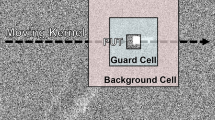Abstract
At present, the global navigation satellite systems’ use as transmitters of maritime surveillance opportunities in passive radar systems is particularly desirable because of global coverage and accurate sources' primary advantages. This paper proposes a global navigation smart radar system for maritime moving object localization and detection. To find and detect underwater targets, signal processing algorithms were used. For finding a transmitting node that can be used during the operation, a multilayered technique is used. The new Galileo satellites and smart systems have been developed to determine the technology's viability and verify the existing signal processing algorithms. The findings show that the machine concept and its multi-service capability are simultaneously observed with two satellites.











Similar content being viewed by others
References
Baumgartner SV, Krieger G (2015) Simultaneous high-resolution wide-swath SAR imaging and ground moving target indication: Processing approaches and system concepts. IEEE J Sel Topics Appl Earth Obs Remote Sens 8(11):5015–5029
Campbell S, Naeem W, Irwin GW (2012) A review on improving the autonomy of unmanned surface vehicles through intelligent collision avoidance manoeuvres. Annu Rev Control 36(2):267–283
Chen X, Guan J, Bao Z, He Y (2013) Detection and extraction of target with micromotion in spiky sea clutter via short-time fractional Fourier transform. IEEE Trans Geosci Remote Sens 52(2):1002–1018
Chen X, Chen B, Guan J, Huang Y, He Y (2018) Space-range-Doppler focus-based low-observable moving target detection using frequency diverse array MIMO radar. IEEE Access 6:43892–43904
Dallinger A, Bickert B (2014) Airborne moving target indication of ground and maritime targets with SmartRadar. In: 2014 international radar conference. IEEE, pp 1–5
Ðorđević ZP, Graovac SG, Mitrović ST (2015) Suboptimal threshold estimation for detection of point-like objects in radar images. EURASIP J Image Video Process 2015(1):1–12
Fefilatyev S, Goldgof D, Shreve M, Lembke C (2012) Detection and tracking of ships in open sea with rapidly moving buoy-mounted camera system. Ocean Eng 54:1–12
Granström K, Natale A, Braca P, Ludeno G, Serafino F (2014) PHD extended target tracking using an incoherent X-band radar: preliminary real-world experimental results. In: 17th international conference on information fusion (FUSION). IEEE, pp 1–8
Hermann D, Galeazzi R, Andersen JC, Blanke M (2015) Smart sensor based obstacle detection for high-speed unmanned surface vehicle. IFAC-PapersOnLine 48(16):190–197
Huizing AG, Otten MPG, Van Rossum WL, Van Dijk R, Maas APM, Van der Houwen EH, Bolt RJ (2009) Compact scalable multifunction RF payload for UAVs with FMCW radar and ESM functionality. In: 2009 International Radar Conference" Surveillance for a Safer World"(RADAR 2009). IEEE, pp 1–6
Jie S, Fu-qing C, Cai-sheng Z, You H (2019) Experimental results of maritime moving target detection based on passive bistatic radar using non-cooperative radar illuminators. J Eng 2019(20):6763–6766
Kuwata Y, Wolf MT, Zarzhitsky D, Huntsberger TL (2013) Safe maritime autonomous navigation with COLREGS, using velocity obstacles. IEEE J Ocean Eng 39(1):110–119
Makhoul E, Broquetas A, Rodon JR, Zhan Y, Ceba F (2014) A performance evaluation of SAR-GMTI missions for maritime applications. IEEE Trans Geosci Remote Sens 53(5):2496–2509
Octavian A, Jatmiko W (2020) Designing intelligent coastal surveillance based on big maritime data. In: 2020 international workshop on big data and information security (IWBIS). IEEE, pp 1–8
Perera LP, Oliveira P, Soares CG (2012) Maritime traffic monitoring based on vessel detection, tracking, state estimation, and trajectory prediction. IEEE Trans Intell Transp Syst 13(3):1188–1200
Ruiz ARJ, Granja FS (2009) A short-range ship navigation system based on ladar imaging and target tracking for improved safety and efficiency. IEEE Trans Intell Transp Syst 10(1):186–197
Santi F, Pastina D, Bucciarelli M (2020) Experimental demonstration of ship target detection in GNSS-based passive radar combining target motion compensation and track-before-detect strategies. Sensors 20(3):599
Setlur P, Smith GE, Ahmad F, Amin MG (2012) Target localization with a single sensor via multipath exploitation. IEEE Trans Aerosp Electron Syst 48(3):1996–2014
Shin BS, Mou X, Mou W, Wang H (2018) Vision-based navigation of an unmanned surface vehicle with object detection and tracking abilities. Mach Vis Appl 29(1):95–112
Tu E, Zhang G, Rachmawati L, Rajabally E, Huang GB (2017) Exploiting AIS data for intelligent maritime navigation: a comprehensive survey from data to methodology. IEEE Trans Intell Transp Syst 19(5):1559–1582
Varshavsky A, Patel S (2018) Location in ubiquitous computing. In: Ubiquitous computing fundamentals. Chapman and Hall/CRC, pp 299–334
Author information
Authors and Affiliations
Corresponding author
Ethics declarations
Conflict of interest
All authors declare that they have no conflict of interests.
Ethical approval
All procedures performed in studies involving human participants were under the institutional and national research committee's ethical standards and the 1964 Helsinki Declaration and its later amendments or comparable ethical standards.
Informed consent
Informed consent was obtained from all individual participants included in the study.
Additional information
Communicated by Vicente Garcia Diaz.
Publisher's Note
Springer Nature remains neutral with regard to jurisdictional claims in published maps and institutional affiliations.
Rights and permissions
About this article
Cite this article
Yang, H., Wang, Q., Li, H. et al. Maritime moving object localization and detection using global navigation smart radar system. Soft Comput 25, 11965–11974 (2021). https://doi.org/10.1007/s00500-021-05625-4
Accepted:
Published:
Issue Date:
DOI: https://doi.org/10.1007/s00500-021-05625-4




